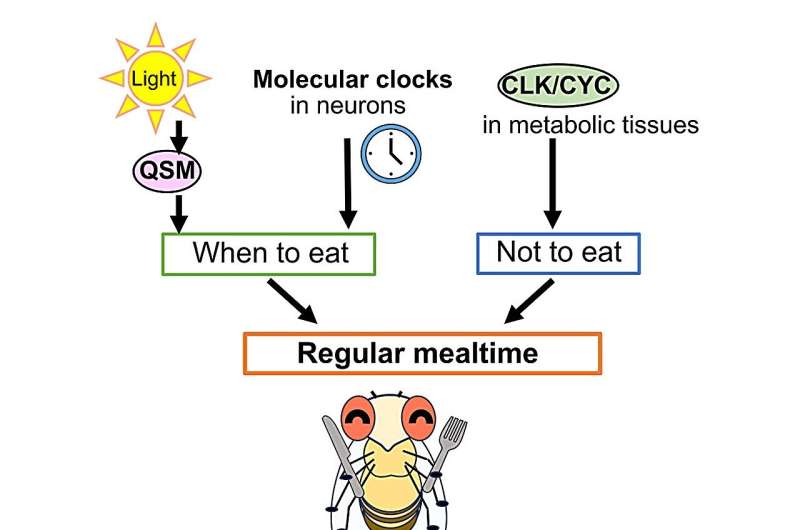This article has been reviewed according to Science X's editorial process and policies. Editors have highlighted the following attributes while ensuring the content's credibility:
fact-checked
peer-reviewed publication
trusted source
proofread
Fruit fly study sheds light on how organisms regulate feeding/fasting cycles

Researchers from Tokyo Metropolitan University have used fruit flies to study how daily eating patterns are regulated. They found that the quasimodo (qsm) gene helped sync feeding to light/dark cycles, but not in constant darkness: instead, the genes clock (clk) and cycle (cyc) keep eating/fasting cycles, while other "clocks" in nerve cells help sync it to days. Deciphering the molecular mechanism behind eating cycles helps us understand animal behavior, including our own.
Many members of the animal kingdom eat at roughly the same times each day. This is born out of the need to adapt to aspects of the environment, including how much light there is, temperature, the availability of food, the chance that predators are around, all of which are vital for survival. It is also important for efficient digestion and metabolism, thus for our general well-being.
But how do such a wide range of organisms know when to eat? An important factor is circadian rhythm, an approximately daily physiological cycle shared by organisms as diverse as animals, plants, bacteria and algae. It serves as a "master clock" which regulates rhythmic behavior. But animals are full of other timing mechanisms, known as "peripheral clocks," each with its own different biochemical pathways. These can be reset by external factors, such as feeding. But the specific way in which these clocks govern animal feeding behavior is not yet clear.
Now a team led by Associate Professor Kanae Ando of Tokyo Metropolitan University have addressed this problem using fruit flies, a model organism that mirrors many of the features of more complex animals, including humans. The research is published in the journal iScience.
They used a method known as a CAFE assay, where flies are fed through a microcapillary to measure exactly how much individual flies eat at different times.
Firstly, they looked at how flies synced their eating habits to light. Studying flies feeding in a light/dark cycle, previous work already showed that flies feed more during the daytime even when mutations were introduced to core circadian clock genes, period (per) and timeless (tim).
Instead, the team looked at quasimodo (qsm), a gene that encodes for a light-responsive protein that controls the firing of clock neurons. By knocking down qsm, they found that flies had their daytime feeding pattern significantly affected.
For the first time, we now know that the syncing of feeding to a light-mediated rhythm is affected by qsm.
This was not the case for flies feeding in constant darkness. Flies with mutations in their core circadian clock genes suffered severe disruption to their daily feeding patterns. Of the four genes involved, period (per), timeless (tim), cycle (cyc) and clock (clk), loss of cyc and clk was far more severe. In fact, it was found that clk/cyc was necessary in creating bimodal feeding patterns i.e. eating and fasting periods, particularly those in metabolic tissues.
But how did these cycles sync up with days? Instead of metabolic tissues, molecular clock genes in the nerve cells played the dominant role.
The team's discoveries give us a first glimpse into how different clocks in different parts of an organism regulate feeding/fasting cycles as well as how they match up with diurnal rhythms. An understanding of the mechanisms behind feeding habits promises new insights into animal behavior, as well as novel treatments for eating disorders.
More information: Akiko Maruko et al, Dissecting the daily feeding pattern: Peripheral CLOCK/CYCLE generate the feeding/fasting episodes and neuronal molecular clocks synchronize them, iScience (2023). DOI: 10.1016/j.isci.2023.108164
Journal information: iScience
Provided by Tokyo Metropolitan University





















